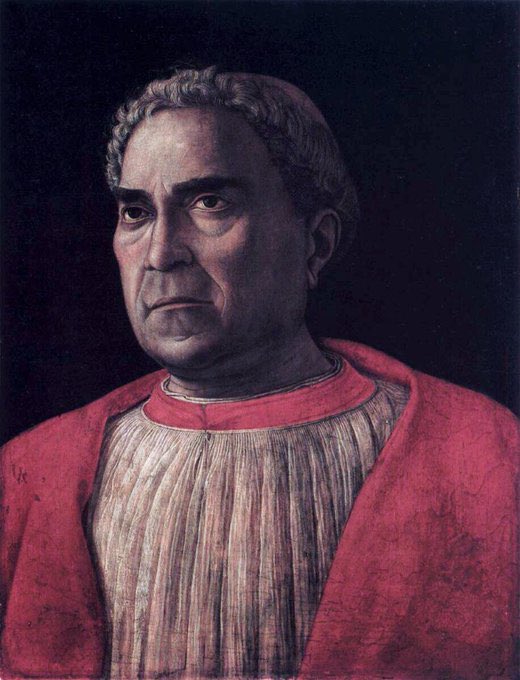mantegnaのTwitterイラスト検索結果。 357 件中 4ページ目
After Mantegna, 1460, tempera painting for #PortraitChallenge @StudioTeaBreak
#kleineKunstklasse
!B
Thursday #PortraitChallenge; pen & ink
Profile portrait of a man after Andrea Mantegna ~1460 @StudioTeaBreak @PoldiPezzoli
Thursday #PortraitChallenge! ✍️
Profile portrait of a man, painted in tempera on panel by Andrea Mantegna sometime around 1460 @StudioTeaBreak
Thursday #PortraitChallenge
Thank you @StudioTeaBreak @PoldiPezzoli
Portrait of a man by Andrea Mantegna c. 1460
My version in acrylics on paper https://t.co/kDC6jk4gqS
Andrea Mantegna ( c. 1431 – September 13, 1506) was an Italian painter.
Mantegna’s work fascinates due to his constant attempt to place biblical events within an archaeologically accurate context - representative of Renaissance learning. His Madonnas are, however, some of the most beautiful examples of Maternal.
The Triumphs of Caesar (1484-92) are 9 works by Mantegna which have been described as his masterpiece. They were painted for Mantua but acquired by Charles I of England in 1629. They have been badly degraded over time but are still an impressive reconstruction of a Roman Triumph
Mantegna sought to explore the emotion of events in the bible. His works of the Madonna & Child achieve great warmth & love. Madonna of the Cherubim (1485), Madonna of the Cave (1488-90) & Ecce Homo (c1500)
Presentation at the Temple (1460), Cardinal Trevisan (1459-60) & St George (1460). The Portrait came about when the Pope commissioned Mantegna to paint the Cardinal who was part of the Council of Mantua (1459). The Council sought to rally Europeans against the Ottomans
The San Zeno Polyptych (1457-60) is another work where Mantegna’s research is apparent. A particular feature are the garlands, inspired by Roman sarcophagi. It was the first major Renaissance work in Verona & he is believed to have designed the frame.
2/2 Dad's having a meeting, the kids are bored. Some things never change. From the camera picta by Andrea Mantegna.
Il #13settembre 1506 moriva #AndreaMantegna. Il più grande classicista rinascimentale. La sua opera innovativa ha molte caratteristiche della cultura rinascimentale: conoscenza dell'antichità classica, spazio prospettico, centralità della figura umana e complessa trama simbolica.
🎨 #AndreaMantegna, Italian Renaissance painter, #DOTD 13 September 1506. #Art #Painting
Andrea Mantegna (c. 1431 – September 13, 1506) was an Italian painter
@albertopetro2 @DavLucia @licprospero @GerardLDonadoni @RitangelaPrivi1 @Rebeka80721106 @karmendida @Hakflak @BrindusaB1 @migliaccio31 @smarucci461 @yianniseinstein @marmelyr @Matibo11 @PasqualeTotaro @BaroneZaza70 @LunaLeso @Make_u2_happy @ManuelaDora @dianadep1 @scastaldi9 @Papryka5 @EnricoCastrovil @PaolaToogoodxme @Dida_ti @erminiopasquat1 @agustin_gut @FreeProOnline @Yadacolorboy @PreziosaGemma @AnnaMar90949897 @Sensibilia8 @CaterinaCategio @gori_magnani @ritamay1 @fra852 @baianer @GaiaGaudenzi @djolavarrieta @cecchi_giovanna @ANNAMAMARIABIA1 @paoloigna1 @GiardinoPietro @BryanMatthews23 @revove22454 @JohnLee90252472 @JohnDante_ @MarisaPetrina @Petra71301259 @MariangelaSant8 ~Andrea Mantegna
~Ecce homo (particolare)
1500
Museo Jacquemart-André, Parigi
Andrea Mantegna 1431 1506 Vergine col Bambino che dorme. Gemaldegalerie Berlino
Julius Caesar on a triumphal car, 1506 #highrenaissance #andreamantegna https://t.co/DXbvSXTiqv
Christ with the soul of the Virgin, 1506 #highrenaissance #andreamantegna https://t.co/aChpb9BC6a
Hercules and Antaeus, 1495 #mantegna #andreamantegna https://t.co/nh1ZQhFkIv















































